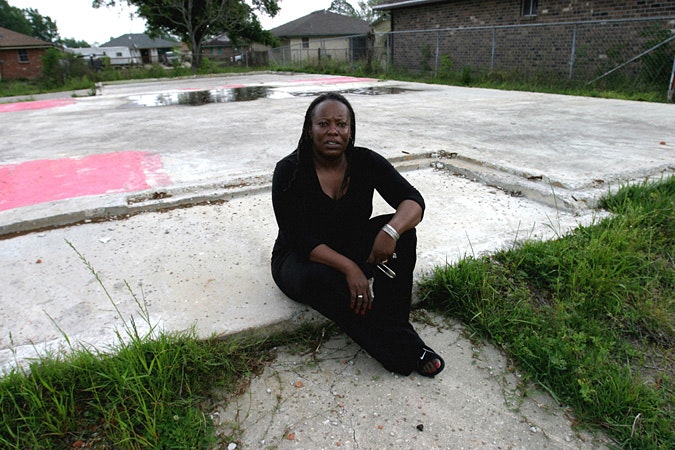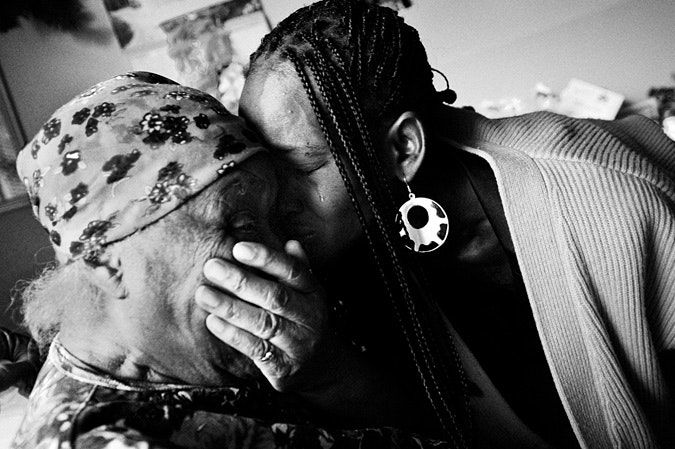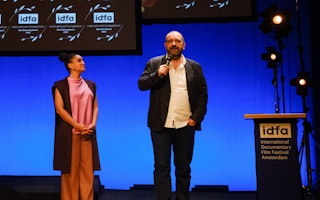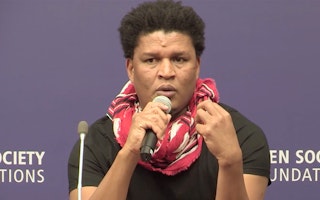Photographers Reflect on Katrina, Five Years Later (Part 1)
By Yukiko Yamagata
In 2006, the Open Society Foundations launched a one-time investigative journalism fellowship to promote a national conversation on racism and inequality in America following Hurricanes Katrina and Rita. The Katrina Media Fellowships supported dynamic print and radio journalists, photographers, and documentary filmmakers to generate and improve media coverage of issues exposed by Katrina.
I asked photographers who received fellowships to reflect back on some of their images and describe how life has changed for the people and places they photographed. The following are some of their stories.
Collette Fournier

This image shows Ann Gaines, a tax advisor, in front of the foundation of her home on Lurline Street in New Orleans East. Her house and car were submerged under ten feet of water. The water damage and resulting mold were so bad that Ann chose to have her home razed.
Ann and her husband Darryl, a nurse, now live in Lake Charles, LA, about 200 miles from New Orleans. They still own the property in New Orleans East, but received such a low estimate from The Road Home Program that they could not afford to rebuild their house. The Gaines had been paying someone to maintain the property in New Orleans East, but they recently learned that the person was neglecting the property.

When Katrina hit, Girard Mouton and his family relocated to Arkansas to live with cousins. I took this photograph eighteen months after Hurricane Katrina. Girard, a professional photographer working at Target, was checking on his mother's property on Buchanan Street in the Gentilly neighborhood of New Orleans. When Katrina hit, Girard’s own house on Press Drive was submerged under eight feet of water. Following the storm and floods, he was determined to reconstruct both houses, but every day he had to battle against government policies that prevented him from rebuilding his two homes.
The state now owns his mother's house and was going to offer her property for sale through the NORA or Road Home Program. Sadly, his mother, a retired educator in the New Orleans school district, passed away in December 2007.
Girard demolished his Press Drive property in November 2007. He hopes to begin new construction in 2011. Like many, he was dissatisfied with the devalued appraisal of his house by The Road Home program. He is immensely frustrated by the process and feels that everyone was shortchanged.
Collette V. Fournier is an award-winning New York-based photographer whose work has been published and exhibited widely and is included in a number of museum collections, such as the Smithsonian Institution and the Schomburg Center for Research in Black Culture. She is a member of Kamoinge, a collective of African American photographers. For her Katrina Media Fellowship project, Fournier photographed people and homes in several New Orleans neighborhoods, including the Lower Ninth Ward, New Orleans East, Gentilly, and Algiers. See more images from Collette Fournier’s Katrina Media Fellowship project.
Kadir van Lohuizen

Kadir van Lohuizen quotes Olevia Polk:
I am the grandmother of Joyce Herring and the great grandmother of Lesly Berzat. I was born in Thibodaux, Louisiana in 1906. As a young girl, I worked on the sugarcane plantations. When Katrina came, I was living in the Calliope Projects in New Orleans. I lived on the 3rd floor. The water came higher and higher. Nobody came to rescue us. In the end, the children managed to find an inflatable swimming pool and pushed me to the ramp of the highway. A bus came and brought me to the Convention Center and after that I was brought to an elderly home in Fort Smith, Arkansas. I had no idea where I was; I was the only person from New Orleans. The last time I saw the family was that morning, on the ramp, in New Orleans. After three years, this is the first time I am seeing somebody from the family; Lesly is visiting me.
Olevia Polk passed away on May 1, 2010. She was 104 years old.
Kadir van Lohuizen is an internationally recognized professional freelance photojournalist and a founding member of Noor photo agency. For his Katrina Media Fellowship project, van Lohuizen captured the life and landscape of New Orleans in the two years following the storm, and followed displaced residents living in Houston as they struggled to rebuild their lives. See more images from Kadir van Lohuizen’s Katrina Media Fellowship project.
We’ll be adding more photos in this series next week.
In the five years since Hurricane Katrina hit New Orleans and the levees broke, residents have developed innovative approaches to tackling some of the city’s—and the nation’s—most persistent problems: criminal justice reform, unresponsive government, and racial and economic inequality. In recognition of these efforts, during the month of August the Open Society Blog shines a light on people and organizations in New Orleans bringing change from within one of the country’s most important cities.

Until December 2021, Yukiko Yamagata was curatorial and deputy director of Culture and Art at the Open Society Foundations.


